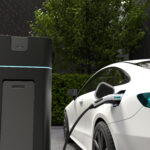Electric car buying guide 2025 isn’t about chasing the longest range or the flashiest badge—it’s about matching an EV to your life, budget, charging access, and long-term costs. This electric car buying guide 2025 walks you through every decision point, from real-world range and charging speeds to home setup, public networks, incentives, safety, software, and ownership math. Follow the steps, and you’ll choose with confidence—not hype.
Quick Facts:
- Official range figures differ by test: WLTP (EU/UK) tends to read higher than EPA (US). Expect lower range in winter and at motorway speeds.
- Charging has two sides: AC (home/work, onboard charger in kW) and DC fast charging (public kW + charge curve).
- Total cost of ownership (TCO) depends more on depreciation, insurance, and energy tariffs than on list price alone.
- Software (route planning with chargers, preconditioning, OTA updates) now matters as much as hardware.

How to use this electric car buying guide 2025
Skim the steps, note your answers (commute, charging, budget, priorities), and short-list two or three models. Then test them on the same day and compare with a simple TCO sheet. The goal of this electric car buying guide 2025 is a car you love to drive and can afford to own—without charging anxiety.
Step 1 — Profile your driving (the truth beats the brochure)
List your typical week: daily commute (km), school runs, errands, and weekend mileage. Add monthly long trips (distance, route, charging availability), climate (winter temps), and parking (on-street, carport, garage). This “life profile” is the backbone of every choice in this electric car buying guide 2025.
Range you actually need
Multiply your longest regular day by 1.5 as a buffer (e.g., 60 km × 1.5 ≈ 90 km). If you can charge at home, almost any modern EV covers daily needs; long trips are about planning and fast-charging—not buying the biggest battery, as this electric car buying guide 2025 emphasizes.
Step 2 — Understand range ratings (WLTP vs. EPA vs. reality)
WLTP (EU/UK) is a lab cycle that often reads optimistic compared to the US EPA test. Real-world range depends on speed (motorway at 120–130 km/h drains faster), temperature (cold reduces range), elevation, tires, and HVAC use. When comparing models, look for independent motorway tests and winter results, not just brochure numbers—core advice in this electric car buying guide.

Step 3 — Charging 101: AC vs. DC, kW vs. kWh, and charge curves
AC charging is the everyday workhorse at home or work. Your car’s onboard charger (e.g., 7.4 kW single-phase or 11 kW three-phase) sets the max AC speed. DC fast charging (50–350 kW) is for road trips. Peak kW matters, but the charge curve—how long the car holds high power—determines how fast you add 10–80% in reality. This electric car buying guide 2025 recommends checking verified 10–80% times, not just peak numbers.
Rule of thumb: For home charging, aim for 11 kW AC if your supply supports it. For road trips, look for a car that sustains high DC power well past 50% state of charge and supports battery preconditioning—consistent with this electric car buying guide 2025.
Step 4 — Home charging: choose the right wallbox and tariff
Home charging is the cheapest, lowest-stress way to live with an EV. A smart wallbox (with load management and scheduled charging) plus a suitable energy tariff will cut costs further. If you live in a flat, check building rules, HOA/WEG permission, and shared infrastructure. Street-parkers should plan for public AC or workplace charging routines; this electric car buying guide 2025 treats home setup as the #1 quality-of-life upgrade.
- Capacity & cabling: Verify your electrical supply (single vs. three-phase), cable length, and whether you need a dedicated circuit.
- Smart features: Load balancing, solar integration, and per-user authentication are worth the extra.
- Tariffs: Off-peak or EV-specific rates can materially lower your cost per 100 km.
Step 5 — Public charging networks: coverage, pricing, and roaming
On the road, you’ll mix high-power hubs with destination AC. Consider coverage, pricing model (per kWh/minute, session/idle fees), access (RFID/app/plug-and-charge), and amenities. This electric car buying guide 2025 suggests mapping your usual corridors and checking reliability before you commit to a model.
Step 6 — TCO reality check: beyond the sticker price
Total cost of ownership differentiates wise choices from expensive mistakes. Run a 4–6 year scenario that includes depreciation, energy, insurance, service/tires, and finance costs. As this electric car buying guide 2025 notes, depreciation and electricity tariffs often move the TCO needle more than list price.
- Depreciation: Biggest line item; brand strength, battery warranty, and demand drive residuals.
- Energy: Electricity tariff × kWh/100 km vs. your previous fuel spend.
- Insurance: Rating groups for EVs vary—get quotes for short-listed models.
- Service & tires: EVs often have low routine service needs, but heavy cars can wear tires faster.
- Financing/Lease: APR or money factor, fees, and mileage caps; consider guaranteed future value offers.

Step 7 — Safety, batteries, and warranties
Prioritize independent crash tests (Euro NCAP, NHTSA) and active safety (AEB, lane assistance). For the battery, look for robust thermal management and a clear warranty (often 8 years/160,000 km with capacity retention terms). This electric car buying guide 2025 also recommends checking the service network and parts availability—particularly for newer brands—so repairs don’t become multi-month delays.
Step 8 — Software, UX, and route planning
Great software removes friction: reliable keyless entry, a clean UI, responsive touch/physical controls, and dependable phone app. For road trips, native route planners that factor elevation, weather, and charger power are invaluable. Over-the-air updates can meaningfully improve range, features, and charging over time—so this electric car buying guide 2025 treats long-term software support as a core spec.
Step 9 — Incentives, regulations, and access
Rules change, but it pays to check for purchase incentives, reduced company-car tax bands, low-emission zone access, preferential parking, or road-toll discounts. This electric car buying guide 2025 advises verifying with official government or municipal pages and confirming eligibility windows before you order.
Step 10 — Test drive smart: simulate your life
Book back-to-back drives on the same day. Bring family members, child seats, and luggage you actually use. Test a short motorway stint to sample noise and lane-change confidence. Try fast-charging during the demo if possible. As this electric car buying guide 2025 stresses, comfort, seating, visibility, and HVAC performance are “range you can feel.”
Step 11 — Buy, lease, or subscribe?
Buying captures residual value but concentrates depreciation risk; leasing fixes monthly costs and offloads residual risk; subscriptions trade higher monthly costs for maximum flexibility and bundled services. Align the deal with your mileage and upgrade cycle. For first-time EVs, this electric car buying guide 2025 suggests a two-to-three-year lease to learn your real charging patterns while tech and infrastructure evolve.
Practical checklist (copy this)
- Profile driving: daily km, winter temps, parking/charging situation, long-trip corridors.
- Short-list three models that fit your life; check motorway and winter range reviews.
- Home charging: confirm electrical capacity, get quotes for a smart wallbox, pick an EV tariff.
- Public charging: map hubs you’ll actually use; compare prices and access methods.
- Run a 4–6 year TCO for each model (depreciation, energy, insurance, tires, finance).
- Confirm safety ratings, battery warranty details, and service network proximity.
- Test drive same-day, same routes; try fast-charging if the dealer allows.
- Choose buy/lease/subscribe based on mileage and upgrade preference.
Three real-world scenarios
Urban commuter (Berlin): 22 km each way, garage with 11 kW AC, occasional weekend trips. A compact EV with 300–400 km WLTP and efficient heat pump is ideal. Low energy cost, easy home charging, and small footprint for city parking—exactly the kind of match this electric car buying guide 2025 is designed to help you find.
Suburban family: School runs plus 2× 600 km holiday trips per year. Look for a mid-size EV with strong DC charge curve (10–80% ~25–30 minutes), roof rails, and rear space. A smart wallbox and off-peak tariff make nightly charging effortless—another win this electric car buying guide 2025 highlights.
Company-car consultant: High motorway mileage and client visits. Prioritize seats, noise insulation, efficient high-speed consumption, native route planning with chargers, and reliable CCS coverage along frequent routes. Leasing often wins for predictable costs, as noted in this electric car buying guide 2025.
FAQ — electric car buying guide 2025
What’s the difference between kW and kWh? kW is power (speed of charging or motor output). kWh is energy (battery capacity). A 77 kWh pack charged at 11 kW AC adds ~11 kWh per hour; at 150 kW DC it can add ~150 kWh per hour at peak (subject to the car’s charge curve)—a key distinction throughout this electric car buying guide 2025.
How long do EV batteries last? Most packs are warranted for 8 years/160,000 km with a capacity retention threshold. Real-world longevity depends on chemistry, thermal management, and charging habits. Moderate, well-planned fast-charging is fine—this electric car buying guide 2025 recommends preconditioning and sensible charge windows on trips.
How much range do I need? Enough to cover your longest typical day with a buffer. With home charging, daily needs are small; long trips are solved by fast-charging and good planning—central themes in this electric car buying guide 2025.
Lease or buy? If you like new tech frequently and want predictable costs, lease. If you keep cars longer and care about residuals, buy. This electric car buying guide 2025 explains both paths so you can match the deal to your life.
Related resources on Bulktrends
- EV Home Charging Guide: Costs, Speeds, Setup
- Hybrid vs Electric Cars in 2025: Which Fits Your Life?
- Used Car Checklist 2025: 50 Things to Inspect
External sources (authoritative)
- Euro NCAP — Latest Safety Results
- US EPA — EV Efficiency & Range
- AFDC — EV Charging Infrastructure Basics
- IEA — Global EV Outlook (latest edition)
Conclusion
The smartest electric car buying guide 2025 decision is the one that fits your life today and still makes sense in five years. Profile your driving, prioritize charging (home first), compare real-world range and charge curves, and run a realistic TCO. Test the finalists on the same day and choose the car that feels right and makes financial sense. Use this electric car buying guide 2025 as your checklist—and you’ll buy an EV you’ll love to live with every day.






